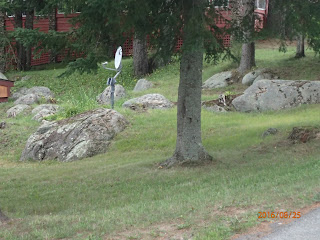Wanakena
 |
| The Inlet Flow, looking toward the Narrows and Cranberry Lake |
|
|
We spent the past week in Wanakena, enjoying the quiet, solitude, and beauty all around us. Although only six miles from Star Lake, Wanakena differs in several ways.
1- What is now known as Cranberry Lake was once a smaller lake, enlarged by damming of the Oswegatchie River near Cranberry Lake hamlet. The Inlet Flow, shown in the above photo was once a river floodplain. It now consists of the relatively deep former river channel and the shallow inundated floodplain. Its character is not quite lake-like and not quite river-like, but somewhere in-between. Star Lake is a glacial lake that has probably been shrinking over the past 10,000 years.
2- Star Lake has clear water, and a sandy bottom. Cranberry lake in contrast has tea-colored water, produced by seepage laden with humic acids leached from fallen leaves and decomposing wood into the Oswegatchie . Note the color of the water in the image below. The bottom may be sand, gravel, or silt.
 |
| Bathing at the Wanakena beach |
3- Star Lake and most of the surrounding area is situated on a thick, relatively flat bed of sand, gravel, and small rocks that are the remnants of a glacial outwash plain. These materials were carried by water rushing out of a melting glacier. Wanakena, in contrast, is built on a glacial moraine. Its rough topography is littered by large rocks, some as big as houses, that were dropped in place by a melting glacier. Note the rocks on Third Street in the image below. The vegetation differs as a result of these differences in geology. Red spruce, for example, is a dominant in the Wanakena area, but relatively rare in Star Lake.
 |
| Rocks dropped by a melting glacier |
4- Wanakena at about 64 people has only about one tenth of the year-round population of Star Lake, but has its own water and sewer systems. Star Lake is served in part by a public water supply, but no public sewers. Neither hamlet has a formal local government, and both are governed as parts of the Town of Fine.
5- In spite of, or in fact because of its small year-round population, Wanakena has a keen sense of community--keener some would say than in Star Lake. Rebuilding of the iconic Wanakena footbridge that was destroyed in an ice jam is one effort that has helped draw the community together.
 |
| Rebuilding the footbridge |
6- The original houses in Wanakena were carried by rail from Pennsylvania, where they had served to house the workforce in a lumbering operation. Reassembled in Wanakena, they resumed their role as supporting workers of the Rich Lumber Company. Some today serve as seasonal residences. Many of the homes in Star Lake were originally built as summer residences, and now serve as full-time dwellings. Only a few were built to serve the workforce at the Benson Mines.

